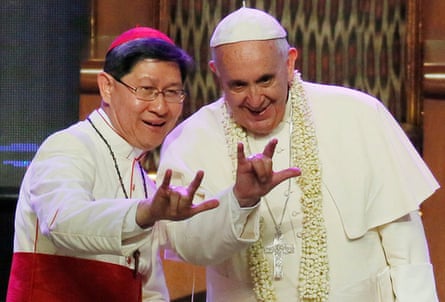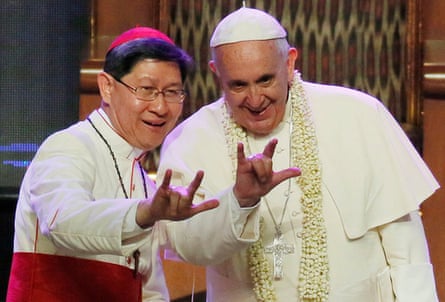At the Quiapo church in the center of Manila, the benches are filled with worshipers. Laters gather near the entrance, tightening the fans to relieve the stifling heat.
A prayer is read in memory of Pope Francis, known affectionately under the name of Lolo Kiko, or grandfather Francis, whose image is framed on the alter.
It is one of the many tributes and services organized in the Philippines in recent days, because one of the largest Catholic populations in the world marks the death of the Pope.
President Ferdinand Marcos Jr declared a period of national mourning, during the pope’s burial on Saturday. Buildings – universities at a shopping center – have held light displays in the papal colors of yellow and white, and in purple, which is often symbolic of penance. In a major artery in Manila, a display panel says: “Pope Francis, thank you very much! We love you.”
Quiapo, like many other churches across the country, sounded the bells to mark his death on Easter Monday.
“Pope Francis is the Pope that we have grown up knowing,” explains Mario Amor, 35, a member of the Quiapo congregation. “For me, he’s a very nice pope.”
On the lively boulevard outside the church, the stands are stacked with rosaries, t-shirts sporting the image of Jesus and the figurines of Catholic saints.
Veronica REPONTE, who had a stand outside the church for two decades, remembers very well when the Pope visited the Philippines in 2015. She took her son, then eight, with her to watch the procession in Manila’s Rizal Park. “I had no waterproof loops and my umbrella could not resist the rain,” she recalls. The miserable time has not prevented the public from presenting themselves. A record crowd of up to 7 million watched its procession.
There had been a frenzy of excitement from the perspective of his arrival. Sales of everything related to the Pope on the Repron stand has skyrocketed – calendars, posters and even decorated handkerchiefs from Francis’s face. “I would have liked to be able to see him again,” she said.
In the Philippines, where 80% of the population is Catholic, the popes are still revered. Francis, however, was particularly well loved. Many remember his visit with emotion in 2015, which came a little over a year after the country had known the devastating typhoon Haiyan who killed more than 6,000 people.
Francis would have been invited to postpone his trip to Tacloban, the most affected region, due to the risk of tropical storm, but he was determined to move forward. In a yellow poncho, beaten by the wind and the rain, he stood in front of thousands of typhoon survivors, saying to them: “I am here to be with you.” Men and women cried while he was talking.
Francis was a pastor who “understood what the sufferings meant for the Philippins” and who visited “at such an important period in our history”, explains Jayeel Cornelio, a sociologist specializing in the role of Catholicism in the contemporary Philippines.
He also opened the church to groups that had been excluded, including the LGBTQ +community. “Many Philippins (described) … on social networks how it was a man, despite the representation of a conservative institution, who gave hope, how faith could evolve,” says Cornelio.
Catholicism, brought to the Philippines by Spanish colonizers in the 16th century, is deeply linked to the culture of the country and has shaped its laws. Abortion is prohibited, and adultery and “cohabitation” bear prison terms of at least six months. It is also the only place in the world, apart from the Vatican, which has no divorce law – although there are efforts to change this – and public opinion has become much more sympathetic for divorce in recent years, reflecting the role or the changing understanding of Catholicism in the country.
The church was once so politically influential that it was at the forefront of the movements to oust two presidents, including the late dictator Ferdinand Marcos Sr. His power has however decreased. The presidency of former chief Rodrigo Duterte, who presided over a “war against drugs” who, according to the activists, killed up to 30,000 people, was a particularly difficult period. The priests were in conflict: some risked reprisals by criticizing the murders, others not.
Duterte remained very popular throughout her presidency, despite the international conviction. Francis worked “under the radar” to provide support to those who spoke, explains Cornelio.
Leila de Lima, former senator and human rights activist who was a fierce criticism of Duterte, wrote in a statement this week: “During one of the darkest moments of my life, I received a rosary from Pope Francis. He came quietly, without fanfare, but his meaning was deep. At that time, I felt seen. I felt recalled. “
Other rights groups also paid tribute. The Filipino group LGBTQ + Bahaghari noted its “progressive but controversial position”. The group said, hoping that Francis’ papacy “becomes the spark” for a more inclusive church.
Now, the Philippins are preparing for the next pope, wondering if he will continue the inclusive heritage of Francis or will return to a more conservative approach.
The next pope will be selected by the College of Cardinals, many of which have been appointed by Francis and reflect a more diverse church.
Luis Antonio Tagle, 67, from the Philippines, is one of those in the running. He has an equally progressive perspective, having suggested that the position of the Catholic Church on gay and divorced couples is too severe. However, he opposed the rights of abortion to the Philippines.
If it is chosen, Tagle would be the first pontiff in Asia, the region with the Catholic population with the fastest growth.

“Italians could still want to be in power, but the signs of time have changed,” explains Cornelio.
If he was named, the country would be delighted, he said. “The Philippines are all about national pride, from Miss Universe to boxing.”
But back to Quiapo church, Mario Amor thinks there are forces superior to the conclave at stake in the selection of the new Pope.
“I’m going to replace him,” he says. “The Lord will name anyone who deserves.”


